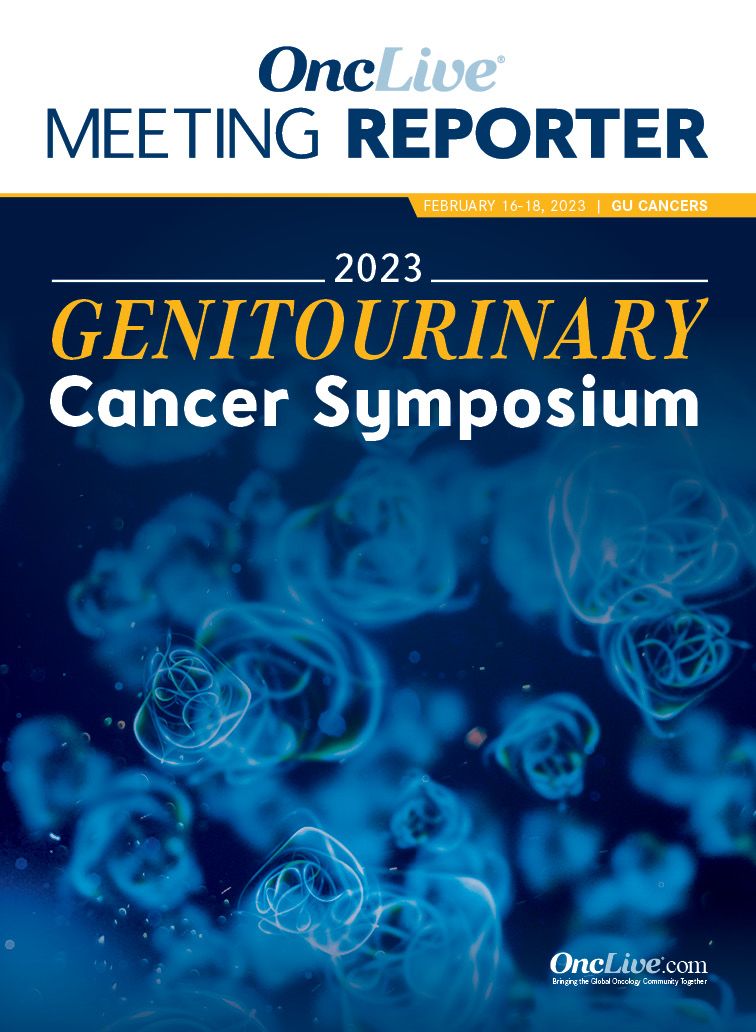Publication
Article
Supplements and Featured Publications
Nivolumab Displays Sustained Survival Benefits in Urothelial Carcinoma
Author(s):
At extended follow-up, nivolumab monotherapy showed improved disease-free survival, non-urothelial tract recurrence-free survival, and disease-specific survival vs placebo in patients with resected, high-risk muscle-invasive urothelial carcinoma.
Matthew Galsky, MD

At extended follow-up, nivolumab monotherapy showed improved disease-free survival (DFS), non-urothelial tract recurrence-free survival (NUTRFS), and disease-specific survival (DSS) vs placebo in patients with resected, high-risk muscle-invasive urothelial carcinoma, according to results from the phase 3 CheckMate 274 study (NCT02632409) presented at the 2023 Genitourinary Cancers Symposium.
In the intent to treat (ITT) population at a median follow-up of 36.1 months vs 33.9 months, respectively, nivolumab continued to yield DFS improvements vs placebo, including in patients with a PD-L1 expression of 1% or more. The median DFS in the nivolumab arm was 22.0 months (95% CI, 18.8-36.9) vs 10.9 months (95% CI, 8.3-15.2) in the placebo arm (Hazard ratio [HR], 0.71; 95% CI, 0.58-0.86). In the population with a PD-L1 expression of 1% or more, the median DFS was 52.6 months (95% CI, 25.8-not estimable [NE]) and 8.4 months (95% CI, 5.6-17.9), respectively (HR, 0.52; 95% CI, 0.37-0.72).
The 24-month and 36-month DFS rates for the nivolumab and placebo arms, respectively, were 48.4% vs 38.8% and 45.0% vs 34.9% in the ITT population. In the PD-L1 population, the rates were 60.3% vs 37.6% and 56.9% vs 33.3%, respectively.
“These results further support adjuvant nivolumab as a standard of care for patients with muscle-invasive urothelial cancer at high risk for recurrence after radical surgery,” according to lead author, Matthew Galsky, MD, a professor of medicine, director of genitourinary medical oncology, and co-director of the Center of Excellence for Bladder Cancer at the Tisch Cancer Institute, as well as the associate director for translational research at the Tisch Cancer Institute, Mount Sinai.
Nivolumab was favored over placebo across all prespecified patient subgroups, including those based on age, sex, region, performance status, minor histologic variance, pathologic lymph node status, and pathological T stage, Galsky noted.
The randomized, double-blind, multi-center study included patients with ypT2 to ypT4a or ypN-positive disease who had previously received treatment with neoadjuvant cisplatin. Eligible patients also underwent radical surgery within the last 120 days and attained disease-free status within 4 weeks of randomization.
Patients were randomly assigned 1:1 to receive intravenous nivolumab at 240 mg every 2 weeks or placebo followed by adjuvant treatment for up to 1 year. Stratification factors included tumor PD-L1 status, previous neoadjuvant cisplatin-based chemotherapy, and nodal status.
The primary end point was DFS in the ITT and PD-L1 of 1% or more populations and secondary end points included NUTRFS, DSS, and overall survival. Exploratory end points included distant metastases-free survival (DMFS), second progression-free survival (PFS2), safety, and health-related quality of life.
The median age in the nivolumab and placebo groups, respectively, were 65.3 years vs 65.9 years. Most patients were White (75% vs 76%), had an ECOG performance status of 0 (63% vs 62%), and had a tumor originating in the urinary bladder (79% vs 79%).
In the ITT population, the median NUTRFS was 25.9 months (95% CI, 19.4-44.0) with nivolumab vs 13.7 months (95% CI, 8.4-20.3) with placebo (HR, 0.72; 95% CI, 0.59-0.88). Among those with a PD-L1 expression of 1% or more, the median NUTRFS was 52.6 months (95% CI, 29.7-NE) vs 8.4 months (95% CI, 5.6-20.0), respectively (HR, 0.53; 95% CI, 0.38-0.74).
Moreover, the 24-month and 36-month NUTRFS rates in the nivolumab and placebo groups, respectively, were 51.6% vs 42.2% and 47.5% vs 38.3%. The rates in each respective group among those with a PD-L1 expression of 1% or more were 62.7% vs 38.3% and 57.4% vs 34.8%.
The median DMFS in the nivolumab arm was 47.1 months (95% CI, 26.5-NE) compared with 28.7 months (95% CI, 16.6-47.8) in the placebo group (HR, 0.74; 95% CI, 0.60-0.92). Moreover, the 24-month and 36-month DMFS rates were 57.8% vs 51.2% and 53.9% vs 47.0%, respectively.
Additionally, the median DMFS was not reached (NR; 95% CI, 44.0-NE) in the nivolumab group for those with a PD-L1 of 1% or more compared with 20.7 months (95% CI, 10.6-NE) in the placebo group (HR, 0.58; 95% CI, 0.40-0.84). The 24-month and 36-month DMFS rates were 66.4% vs 48.6% and 61.7% vs 44.2%, respectively.
Median PFS2 was 61.2 months (95% CI, 44.0-NE) with nivolumab vs 47.1 months (95% CI, 29.4-65.2) with placebo in the ITT population (HR, 0.79; 95% CI, 0.63-0.98). Additionally, median PFS2 was NR (95% CI, NE-NE) compared with 39.4 months (95% CI, 25.2-NE; HR, 0.54; 95% CI, 0.37-0.79) in the PD-L1 subgroup following treatment with nivolumab and placebo, respectively.
The 24-month and 36-month PFS2 rates with nivolumab and placebo, respectively, were 71.4% vs 60.7% and 61.0% vs 53.8% in the ITT population and 78.8% vs 59.3% and 70.6% vs 51.4% in the PD-L1 subgroup.
Galsky went on to summarize how efficacy outcomes changed over time.
“[When examining] efficacy outcomes over time from the initial report with a minimum follow up of 5.9 months to the current presentation with a minimum follow up of 31.6 months, you will note that across primary, secondary, and exploratory end points the effect of adjuvant nivolumab vs placebo is remarkably stable over time,” he said. “It's important to point out that this is with a fixed duration of treatment—limited to 1 year of adjuvant treatment with sustained effects over time.”
A total of 79% of patients experienced any-grade treatment-related adverse effects (TRAEs) in the nivolumab arm compared with 56% in the placebo arm, with 18% and 7% experiencing grade 3 toxicities or higher, respectively. Moreover, 14% of patients and 2% of patients experienced any-grade TRAEs leading to discontinuation, respectively.
Common TRAEs in the nivolumab arm included pruritus (23%), fatigue (17%), and diarrhea (17%), with grade 3 or higher toxicities including lipase increase (5%) and amylase increase (4%). Frequent any-grade TRAEs in the placebo arm were fatigue (12%), pruritis (11%), and diarrhea (11%). Grade 3 or higher toxicities in the control arm included lipase increase (3%) and amylase increase (1%).
Reference
Galsky M, Witjes JA, Gschwend J, et al. Extended follow-up results from the CheckMate 274 trial. J Clin Oncol. 2023;41(suppl 6):LBA443. doi:10.1200/JCO.2023.41.6_suppl.LBA443









